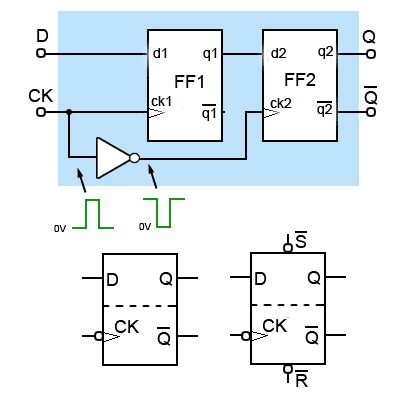

5.3.1 shows this as a ‘don’t care’ state (X). Operation.Īs long as the clock input is low, changes at the D input make no difference to the outputs. The S and R inputs are now replaced by a single D input, and all D type flip-flops have a clock input. This simple modification prevents both the indeterminate and non-allowed states of the SR flip-flop. The simplest form of D Type flip-flop is basically a high activated SR type with an additional inverter to ensure that the S and R inputs cannot both be high or both low at the same time. To avoid the ambiguity in the title therefore, it is usually known simply as the D Type. 5.3.1 together with its truth table and a typical schematic circuit symbol, may be called a Data flip-flop because of its ability to ‘latch’ and remember data, or a Delay flip-flop because latching and remembering data can be used to create a delay in the progress of that data through a circuit. its indeterminate output and non-allowed logic states) described in Digital Electronics Module 5.2 is overcome by the D type flip-flop. Latches are responsive towards faults on enable pin.The major drawback of the SR flip-flop (i.e. The latch cannot be built from the gates.įlip-Flop cannot be built from the latches. The latch is asynchronous because latch does not work on the basis of the time signal.įlip-Flop is synchronous because flip-flop work on the basis of the clock signal. The latch cannot be used as a register because the register requires more advanced electronic circuits where time plays an essential role.įlip-Flop can work as a register because it contains clock signals in its input. The latch is sensitive to the input and as long as it is 'On', we can transmit the data.įlip-Flop is sensitive to the clock signals and until there is a change in the input clock signal, it never changes the output. Only binary inputs can be used to operate the latches.īy the clock signal and binary input, the Flip-Flop works.

Latches are fast as compared to the Flip-Flop.įlip-Flops are slow as compared to the latches.įor all the time, Flip-Flops are clocked. To form sequential circuits, Flip-Flop is constructed from latches along with an additional clock signal. To form sequential circuits, latches are constructed from logic gates. We can classify the flip-flop as synchronous or asynchronous flipflops. Mostly, there are four types of Flip-Flops:ĭifference Between Latch and Flip-Flop S.NoĪ Latch is a bistable device, and the state of the latch is represented as 0 and 1.įlip-Flop is also a bistable device and there are two stable states of Flip-Flop, which are represented as 0 and 1. Mainly, in the synchronous sequential circuit, flip flops function as a memory element, and in asynchronous sequential circuit, the unclocked flip flops or latches function as a memory element. When the clock pulse is active, then the state of the flip-flop is active, and when the clock pulse is not active, then the state of the clock pulse remains unaffected. In a sequential circuit, the output is obtained from the combinational circuit or flip-flop or both. In a sequential circuit, we use flip-flops as a memory element. Flip-flop is also called a bistable multivibrator or one-bit or binary. The fundamental blocks of various sequential circuits are flip-flops. Flip-Flopįlip-flop is a digital memory circuit, and with the help of the flip-flop we can store one bit of information. The Latch does not work on the clock edges like the flipflop. A latch is just like a flip-flop, but latch is not a synchronous device. We use latch to store one bit of data and it is a memory device. The "SET" and "RESET" are two inputs in a latch, and there are two outputs that are complement to each other. We use latch to store either 0 or 1 at any specified time. Next → ← prev Difference between Latches and Flip- Flops LatchĪ Latch is an electronic device that instantly changes its output based on the applied input.


 0 kommentar(er)
0 kommentar(er)
